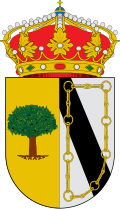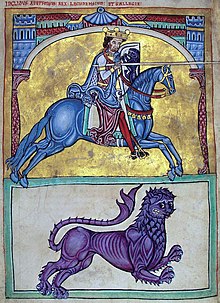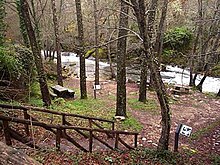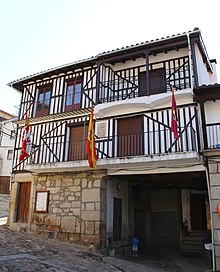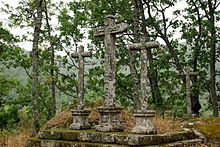The Count's Houses
Las Casas del Conde is a Spanish municipality and town in the province of Salamanca, in the Leonese Region of the autonomous community of Castilla y León. It is integrated into the Sierra de Francia region. It belongs to the judicial district of Ciudad Rodrigo and to the Sierra de Francia Commonwealth.
Its municipal area is made up of a single population center, it occupies a total area of 1.26 km² and according to the demographic data collected in the municipal register prepared by the INE in 2017, it has a population of 56 inhabitants.
Symbols
Shield
The heraldic shield that represents the municipality was approved on June 8, 2006 with the following coat of arms:
«Party. First barracks, olive in its color, on gold fields. The weapons of the second barracks are those of the Houses or State of Zuñiga, for the connection of the Houses of Count with the county of Miranda del Castañar. Square field with a sable band (black) and an eight-link gold chain, oral and brocante. It should be sown with a Royal Crown of Spain, which is a circle engraved in precious stones, with eight flowers (five seen), of acant leaves, interpolated with pearls and of whose leaves come many diadems, added of pearls that converge in a world of sugar (blue), with the semi-rindian and equator, of gold added to a golden cross and the forged crown.»Official Gazette of Castile and Leon No. 122 of 26 June 2006
Flag
The municipal flag was also approved on June 8, 2006 with the following textual description:
«Rectangle of proportions 2:3, formed by a cloth of gules (red). In the center of the flag the municipal shield»Official Gazette of Castile and Leon No. 122 of 26 June 2006
Geography
Las Casas del Conde consists of two neighborhoods: the Old and the New, between which a stream crosses and are connected by a bridge. As reflected in the ecclesiastical archives, its first name was Las Casas del Sapo, later renamed Villanueva de las Casas and definitively, Las Casas del Conde.
Climate
The average annual temperature of Spain is 13.40 °C, which is 0.43 °C higher than the average annual temperature of Spain which is 12.97 °C. In the warmest months the average temperature is 34.60 °C and in the coldest months the average temperature is 0.90 °C. The average annual rainfall in Las Casas del Conde is 1156mm, which is 511.7mm higher than the average annual rainfall of Spain (644.3mm).
Hiking
There are several hiking trails in Las Casas del Conde
- San Martín del Castañar - Las Casas del Conde - Sequeros and return by the curators.
- La Alberca - Las Casas del Conde - Sequeros - San Martín del Castañar - La Alberca.
- San Martín del Castañar - Las Casas del Conde - El pared - San Martín del Castañar.
- San Martín del Castañar - Mogarraz - Monforte - Las Casas del Conde - San Martín del Castañar.
- Sierra de Francia 2 (Mogarraz, Miranda del Castañar, Villanueva del Conde, Sequeros and San Martín del Castañar).
- Sequeros, Las Casas del Conde and San Martín del Castañar.
- Circular Sierra de Francia.
Transportation
Public transport: Bus line Salamanca-La Alberca-Mogarraz. Salamanca Bus Station.
It is located 76 km from Salamanca, along the C-512 regional road.
On summer nights, an overnight bus known as the "mountain owl" runs through the municipalities of Herguijuela de la Sierra, Madroñal, San Miguel del Robledo, Mogarraz, El Maíllo, Las Casas del Conde, San Martín del Castañar, Monforte de la Sierra, La Alberca, Villanueva del Conde, Cepeda, El Cabaco, Miranda del Castañar and Garcibuey in order to avoid that young people have to travel by car to the festivals of neighboring towns and thus avoid traffic accidents with alcohol as a cause.
History
Like most of the towns in the region, Las Casas del Conde was born in history during the Christian repopulation, begun in the time of Alfonso VI of León (1065-1109) in the hands of his son-in-law, Count Raimundo de Borgoña. As the wars of the Muslims continued to threaten Christian Spain, Alfonso IX of León intensified the repopulation activity and fortified this area, which belongs to the Kingdom of León and borders both the Muslims and the Kingdom of Castile. As can be seen from the origin of its name, the municipality soon became part of the jurisdiction of the Count of Miranda del Castañar, with the economic dependence that this implies, due to the establishment of feudal rents, applied to all assets. economic and material neighbors. An important brake on the development of the town, until in 1757, the King granted the title of town to Las Casas del Conde, awarding him a large part of the land of El Cabaco, Nava de Francia and El Casarito.
This distribution originated the beginning of a very long lawsuit between Las Casas and El Cabaco, in which there were no shortage of fights, assassination attempts and even the presence of soldiers, sent by the district governor, who lived in Ciudad Rodrigo.
Some authors report that those from Las Casas del Conde, more aggressive due to their condition as mountain rangers, wounded, stabbed and even seriously disgraced several residents of El Cabaco. In 1763 the case was ruled in favor of the Cabaqueños, who recovered their communal forests. The complete minutes of this lawsuit occupy no less than 1720 handwritten pages in folio and the sentence is contained in another volume of 180 pages.
Years before, the residents of Las Casas also had serious disputes with Mogarraz, over the exploitation of the Santa Coloma meadow. In 1672 there was one death and several wounded in a brawl, which triggered a period of greater understanding, and the following year peace was signed, Mogarraz paying 14,300 reales for the pasture. However, the lawsuits continue over the years due to problems of use of dry trees without fruit, pruning, costs, thinning, etc., giving rise to the sentence of the Royal Chancery of Valladolid, enforceable on February 28, 1738, in reference to the places of Mount Peñalvo, already regulated in the ordinances of the third count of Miranda, and to the properties towards San Blas and the vicinity of the Francia river
With the creation of the current provinces in 1833, Las Casas del Conde was included in the province of Salamanca, within the Leonese Region.
Flora and fauna
It is located near the Francia River, which rises in the mountain range of its name, like all mountain rivers its waters are crystal clear and its course runs through vegetation made up of alders, ash trees, etc., which tend to seek light solar reaching high altitude contributing to form a tunnel around the river which contributes in the summer period to enjoy a peaceful environment, only disturbed by the noise of the water in its passing. Las Casas del Conde nestled in lush chestnut and oak forests has a privileged microclimate, given its geographical location, which allows the cultivation of all kinds of fruit trees (cherry trees, fig trees, apple trees, pear trees, olive trees, vines, etc.) even those of the Mediterranean type (orange, lemon, etc.). As for the vegetation, it is very rich in aromatic plants (thyme, oregano, etc.). In January the daffodils have already bloomed around the river or in humid meadows, which gives an idea of the climate of this town given its geographical location (inside between two mountains, next to the mentioned river and facing the ledge).
Cuckoos, partridges, wood pigeons, turtle doves, robins, buntings, blackbirds, shrikes, wagtails, tits and a long list of inhabitants demonstrate the ornithic richness of these places. In bird watching, raptors have a large representation, with such characteristic species as the seriously endangered imperial eagle, the golden eagle, the peregrine falcon or the great black and griffon vultures. Forest birds of prey such as booted and short-toed eagles, buzzards, kites, goshawks and hawks or nocturnal birds of prey such as the imposing eagle owl, long-eared owl, owl, scops owl or little owl are relatively common.
Reptiles, with great diversity, are the best represented group of vertebrates, along with birds. Three endemic species of the Iberian Peninsula stand out: the black-green lizard, the mountain lizard and the bocage lizard. We can also find the ladder snake, the viperine snake and the bastard snake.
The most common species of amphibians that we can find in these places are the long-legged frog, the green frog, the San Antonio frog, the common toad, the salamander, the marbled newt and the Iberian newt.
Of great interest is the presence, albeit scarce, of badgers, martens, weasels, otters and various species of bats, some of which are truly endemic. In the 1970s, roe deer and deer were reintroduced for hunting use, with different luck because the deer has not been as successful as the roe deer. The fox is the most frequent predatory mammal. Wild boars abound, and the presence of hedgehogs, moles, voles, dormouse, field mice, shrews, and rabbits complete the range of mammals.
Among the variety of fluvial fish that we can find in the Francia River, we can highlight species of transparent waters headed by the common trout, the catfish and the less frequent russet and fangs. Although in recent years after the repetitive illegal dumping upstream, accompanied by a general decrease in rainfall, these highly sensitive populations have been considerably reduced.
Demographics
| Graphic of demographic evolution of Las Casas del Conde between 1900 and 2021 |
 |
Source: Spanish National Statistical Institute - Graphical development by Wikipedia. |
According to the National Statistics Institute, as of December 31, 2018, Las Casas del Conde had a total population of 61 inhabitants, of whom 28 were men and 33 women. Regarding the year 2000, the census reflects 88 inhabitants, of which 40 were men and 48 women. Therefore, the loss of population in the municipality for the period 2000-2018 has been 27 inhabitants, a 31% decrease.
Culture
Architecture
In addition to the houses, the squares and the streets they overlook, constitute the physiognomy of popular mountain architecture. Both one and the other are paved with granite stones, which gives these spaces their personality; on occasions, large granite boats form true ruts on main streets. There is no shortage, in the most diverse corners, stone transepts sometimes elevated and surrounded by granite stairs. These are part of a Stations of the Cross that culminates in a beautiful representation of Calvary with three crosses where the central one bears engravings of the instruments of Christ's passion: the nails, the tongs, the whip... Another element that we come across are the fountains, which flow continuously through their pipes and which give the flow of time that regular and monotonous sound. Rumor of sources, so characteristic of the Sierra de Francia. And balconies covered by pots and flowerpots when the good weather arrives; geraniums with different shades of red and with white and green, which give liveliness to the streets and squares. Within this urbanism, the portico is especially important, present in some squares above all, as shelter and privacy. And the covered passageways. And the hidden corners that seem to not exist. And the poles? They are granite blocks, attached to the façade of the ground floor of each house, where people sit to take in the fresh air during good weather and where women sew on long summer afternoons. They contribute to form very mountainous prints, which are still very much alive. All these elements constitute an invitation for a long journey in which the traveler will fill his eyes with continuous surprises, if he is willing to let himself be captivated.
Gastronomy
Both the fruits and vegetables are grown in small orchards under a minifundio system, for which water is never lacking, pure and abundant. In this way, cherries are obtained, in a great boom today, apples, pears, figs, chestnuts, walnuts, persimmons and strawberries, which had their good economic moment a few years ago, although the same is no longer the case today. Nor should we forget vegetables such as green beans, tomatoes, peppers, onions, potatoes, cabbage... all of them garden products, which have an excellent flavor in the Sierra, which they do not lose as they do not have to undergo a long process of commercialization. Gastronomically speaking, the two genuinely Mediterranean products that are found in Las Casas del Conde are important: olive oil and wine. The first is of great purity and gives the dishes cooked with it an intense and aromatic flavor; At the end of autumn and beginning of winter, the olives are collected and taken to the oil mills (oil mills), which are in several towns, to extract an oil from it that, due to its quality, would well haberdashery be better known. Olives are also collected, at an earlier time (late summer), to season them and eat them when they have taken on the flavor. The wine deserves a separate epigraph. The gastronomic interest of certain wild products that nature gives is notable. Autumn is the time of mushrooms, which can be tasted with special acceptance, among the various types that exist, the “macrolepiota procera” (parasol) florets, which are roasted in the embers of the fire, with oil and salt, and the mushrooms ("boletus edulis"). During the winter, towards the beginning of it, the strawberry trees ripen, very reddish, in the forests where the shrub grows; If they are poured into brandy, a pleasant liquor is obtained; They can also be eaten, without further ado, as a fruit.
Bread and sweets
There are festive moments in which bread, in one form or another, acquires a ritual character of celebration; The hornazo is a paschal bread, which is eaten when Holy Week ends; Its dough is the same as that of common bread but it also contains oil, which gives its crumb a yellow color, and saffron, which intensifies this color helped by the paprika from the chorizo in the crust; inside, it has an egg, surrounded by capaúras (pieces, from one tied to another of the rope) of chorizo, as if it were a pie; sometimes, pieces of ham and loin are added. They constitute the characteristic snack of the Easter festivities. The sweets (the name given to the pasta) are prepared for the patron saint festivities and those of greater importance. There are many types; Its most common ingredients are flour, eggs, milk, lard, oil, sugar, aniseed... They receive names such as mantecados, biscuits, turruletes, perrunillas, floretas, puchas, sacatrapos, etc., never lacking in weddings and baptisms.
Some dishes
There are dishes and stews that, traditionally, have never been lacking on designated occasions or at certain times of the year. The serrano lemon is one of the most characteristic; it is taken in the winter time, from the beginning of the Carnival until Easter; Its ingredients are oranges, lemons (one for every four or five oranges), boiled eggs, chorizo casings, a few cloves of garlic (very few) and wine (or vinegar), oil and salt. Chop the oranges, lemons and egg whites in a suitable container, add the chopped and fried capauras to it (you can also add marinade) and finely chop the garlic; The yolks are dissolved in the oil (from frying the capaúras) and wine, and everything is poured into the bowl in which the chopped pieces are found, adding the necessary salt. A dish that has never been lacking in wedding banquets, when the meals were held at the home of the groom's parents, has been the almondeguillas (meatballs); even, after the wedding, to invite someone who had not been invited, a small plate with some was brought home for the family to try. They are made with minced meat (the meat is mixed with ham and bacon) and wrapped with beaten egg, breadcrumbs, garlic, parsley and salt; they are fried and then cooked. The kid has always been and continues to be a delicacy on days of festivities and celebrations; one of their stews is the so-called cuchifrito kid; to prepare it, the kid is chopped; pieces of garlic are fried in a pan with abundant oil, which are then removed and reserved; then the pieces of the kid are fried and placed in a dish and, on top of them, the garlic is thrown, with hot oil, and the brains of the kid itself, diluted.
Quality Wine from the Sierra de Salamanca mention
- Wine in Las Casas del Conde (breakable link available on the Internet Archive; see history, first version and last).
- Resolution BOE Thursday, September 23, 2010
DESCRIPTION: Rosé and red wine (table wine with the right to use the Sierra de Salamanca Geographical mention). The rosés will easily exceed 12% of their volume in alcohol and are made with a high percentage of the Rufete red variety, along with the other red varietals, and especially whites such as Verdejo and Viura. Red wines, with an alcohol content generally higher than 12.5 degrees, will be made with a percentage of more than 60% Rufete grape varieties, which is considered the main and most abundant; Other regional varieties take part in the rest, Garnacha Tinta and, to a lesser extent, Tempranillo, which in this area was known as Tinto de Madrid. Order of December 23, 1999 by which the annexes of the Order of January 7, 1998 are updated, in relation to the updating of the geographical names and the mention Vino de la Tierra in the designation of table wines, in which the Sierra de Salamanca appears in Annex II, corresponding to that of other regions with the right to use the geographical mention in table wines.
HISTORY AND SPACE DISTRIBUTION: The origins of the vineyard in this area go back to Roman times, but, after the Muslim conquest of the Iberian Peninsula, these lands, which did not become depopulated, suffered economic recession, and only after the consolidation of the reconquest were they intensely repopulated, with which, it is from the XI century, when the vineyard begins to reappear, in the environment of a well-founded economy in cereals, livestock and oil. Throughout the XIX century, the vineyards of these lands experienced a strong expansion, becoming one of the economic pillars of the region, until reaching the maximum with exports to France due to the phylloxera crisis. And, it is precisely at the end of the XIX century, when the phylloxera plague entered the region from Portugal and destroyed everything his vineyard, which recovers quickly, consolidating itself definitively, in association of cultivation, with the olive tree and the fruit trees. At the end of the fifties of the XX century, the cooperative wineries of the area were created, which played a prominent role in the introduction of new techniques and in the conservation of the vineyard, having guaranteed the sale of its bulk. The region is an area where terraced vineyards are cultivated on a very small area with little mechanization, including 14 municipalities.
QUALITIES: These are wines of great originality, granted by the varietal of the Rufete area, endowed both for the production of young wines and for aging ones, manifesting itself as a variety with great aging capacity and resistance to oxidation.
STRENGTHS, WEAKNESSES AND OPPORTUNITIES: This area has a variety considered to be an autochthonous grape, called Rufete, with unique characteristics and personality. In addition, the vines are old, between 45 and 50 years old, which gives the grape quality for aging wines. The favorable climate and soil in the area mean that the harvests are regularly good. The name of the region, its varietals and the typology of its wines are still not sufficiently known by the extra-provincial consumer.
POPULAR
The vines have already been dug
and the hawthorns;
God give health to the master
and the workers.
Parties
- Feasts of the Holy Christ and Virgin of the Triomphe: 7, 8 and 9 August
- Exaltation of the Holy Cross: September 14.
Monuments and places of interest
Settlement-forest of mirrors road
The settlement-bosque de los espejos road is a circular route about 9 km long that runs through the towns of San Martín del Castañar, Sequeros and Las Casas del Conde. Among the artistic works that can be seen are A puntadas or La casa del arbol, by Luque López, by Luque López, Mochuelos, by Pablo Amargo, or Magenta Mayflies, by José Antonio Juárez. Particularly noteworthy are the artistic carvings that have been made on certain olive trees in Las Casas del Conde. The path passes at times through an old stone path with a certain singularity, as well as farms, walls and stairs that overlook the vineyards of the place.
Others
- Church of Santa Catalina.
- Humilladero hermitage.
- Interesting urban helmet.
- Viacrucis.
- Natural lookout.
- Central Centenary hydroelectric plant.
Administration and politics
Municipal elections
Las Casas del Conde is a small municipality, however, there is a lot of political activity. Four different candidacies were presented in the 2011 municipal elections.
| Political party | 2019 | 2015 | 2011 | 2007 | 2003 | ||||||||||
|---|---|---|---|---|---|---|---|---|---|---|---|---|---|---|---|
| % | Votes | Councillors | % | Votes | Councillors | % | Votes | Councillors | % | Votes | Councillors | % | Votes | Councillors | |
| Spanish Socialist Workers Party (PSOE) | 50.79 | 32 | 2 | 39,53 | 17 | 2 | 63.64 | 35 | 2 | 40,68 | 24 | 0 | 41,07 | 23 | 0 |
| Popular Party (PP) | 49,21 | 31 | 1 | 20,93 | 9 | 0 | 21,82 | 12 | 1 | 57.63 | 34 | 1 | 58.93 | 33 | 1 |
| Citizens (Cs) | - | - | - | 18,44 | 33 | 0 | - | - | - | - | - | - | - | - | - |
| Common | - | - | - | 30,23 | 13 | 1 | - | - | - | - | - | - | - | - | - |
| United Left (IU) | - | - | - | - | - | - | 12,73 | 7 | 0 | - | - | - | - | - | - |
The mayoress of Las Casas del Conde does not receive any type of financial benefit for her work as head of the town hall (2017).
Contenido relacionado
Puerto Serrano
Swamp
Ratchet
